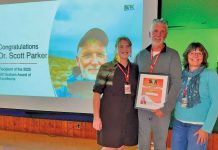By Joanne Rodgers, Bruce Peninsula Press
Owen Glendon of the Citizen Science Seabin Project hosted a training session for volunteers overseeing the Seabin this summer in Lion’s Head.
On May 16, seven volunteers braved a very chilly windswept evening at the Lion’s Head Marina to learn about their tasks relating to managing the garbage captured by the Seabin. The Citizen Science Seabin Project aims to monitor the garbage found in the water and to raise awareness of the quantity and types of waste, especially plastics that are found in our waters.
The Seabin is described as “an underwater garbage collector mounted on a floating platform that sits below the water surface level. Its marine grade, stainless steel frame and high density polyethylene basin is ocean worthy but best suited for calm waters, such as inner harbours. The container has an inner mesh basket and a pump that pulls surface water and debris into the basket.”
To provide a visual aid and to raise awareness of the receptacle, “Inspector SeaBin” was created. This cutout is attached above the Seabin, and displays a QR code which is linked to a website providing more details on the project.
Volunteers will follow well-established protocols laid out by the University of Toronto. Each day, a volunteer will check the Seabin. If full, the volunteer will empty it and weigh the debris. Data on the weight, amount of debris in the bag and weather conditions will be submitted through the “Data Trapper’ App via a smartphone to the International Trash Trap Network.

Glendon says there will not be debris every day, but the absence of garbage is also important data. Heavy rains may send more debris into the water via the storm sewers, quickly filling up the Seabin. All data is useful to understanding the overall picture of what is polluting the Great Lakes.
During the training session the Seabin was being clogged by algae, but one plastic shopping bag was also ensnared by the Seabin.
Several times this summer the volunteers will conduct a “deep dive” of the captured debris. They will lay out all the garbage collected, sort and catalog the debris using sieves and tweezers. Their findings will be also submitted to the larger study.


The local Seabins were first deployed in 2021 as a pilot project with Georgian Bay Forever, Parks Canada and the Municipality of Northern Bruce to study the water quality in Fathom Five Marine Park. In 2022, the three Seabins became part of a Citizen Science based project under the administration of the Sources of Knowledge Forum with partners Friends of Bruce District Parks and Parks Canada.
Persons interested in helping to monitor the Seabin in Lion’s Head, can contact Owen Glendon via email owenglendon@me.com
For further information on the project visit https://sourcesofknowledge.ca/seabins/















